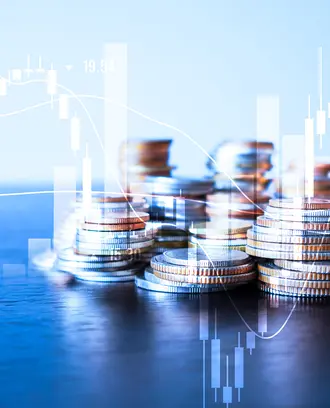Credit: Rob Dobi
Circuit breakers are usually thought of as a necessary timeout for investors when markets go wild. They were first implemented in U.S. stock markets after the Black Monday stock crash of 1987 as a way to pause trading and restore stability during unprecedented times of volatility.
“In the U.S., most people view circuit breakers as a necessary tool, especially when the market is in a state of chaos,” saida professor of finance at MIT Sloan.
On Black Monday, the Dow Jones Industrial Average dropped by more than 20%, and there were clear signs of dysfunction in the market, Chen said. After that incident, “regulators thought that, if we were to be in such a situation again, it would be a good idea to pause the market [and] let everybody take a deep breath and gather some information so that they can make more informed decisions as opposed to trading in a panic,” he said.
At the onset of the COVID-19 pandemic, the U.S. stock market circuit breaker was triggered four times in 10 days.
In the U.S., when the S&P 500 index declines by at least 7% from the previous day’s closing price, a marketwide circuit breaker is triggered that halts trading for 15 minutes. There are two other circuit breakers that have not been triggered to date: one that would implement an additional 15-minute pause for a 13% decline, and one that would end trading for the day if the decline were to hit 20%.
From its initial adoption in 1988 to the beginning of 2020, the U.S. marketwide circuit breaker was triggered only once — on Oct. 27, 1997. Then, at the onset of the COVID-19 pandemic, it was triggered four times in 10 days.
Trial and error in circuit breaker design
Before it took on its current form, the circuit breaker rule in the U.S. went through several modifications, including a change in the underlying benchmark index (initially based on the Dow and later switched to the S&P 500) and adjustments to the thresholds (which have been loosened and tightened several times) and the length of trading halts.
During this period, the majority of other major markets around the world also adopted circuit breakers whose specific designs varied across markets. “Unfortunately, regulators have little guidance on how to design circuit breakers,” Chen said. “It was based largely on intuition and trial and error.”
China introduced its own version of a circuit breaker in January 2016, in hopes of stabilizing the market following a turbulent stock market decline in 2015. It chose a tighter threshold of 5%. That circuit breaker was triggered on two of the first four days after it was installed, and it was quickly abolished afterwards.
“It was clearly not a successful experiment” in China, Chen said. “But what was the cause behind it? Could the policy have been designed differently to prevent something like this from happening?” A similar question can be asked about the recent U.S. experience, Chen said: “Was it necessary to pause the market so frequently when it was going through a major fundamental shock?”
Chen decided to look further into the impact of circuit breakers in financial markets in order to help regulators design them better.
Building a model to account for the influence of circuit breakers
As described in their report “The Dark Side of Circuit Breakers,” Chen and his co-authors developed a dynamic equilibrium model to evaluate the consequences of circuit breakers for price dynamics and investor trading behavior. By comparing the model outcomes in two settings, one with a circuit breaker in place and the other without, they could isolate the effect from the circuit breaker.
The model showed that the presence of a circuit breaker generally lowers the overall price level and substantially alters price dynamics. As the market drops closer to the circuit breaker threshold, the conditional price volatility rises sharply while returns exhibit negative skewness with an increasing magnitude.
Both effects reflect the fact that a circuit breaker tends to destabilize the price during large market declines.
One consequence of such price dynamics is that as the market falls closer to the circuit breaker, the likelihood of a circuit breaker trigger rises at an accelerated pace. This is the so-called “magnet effect” often suspected by market participants.
Here’s why these effects occur in the model: A trading halt forces investors to hold their stock positions for an extended period without the ability to rebalance in response to news in the market, which could prove risky when fundamental uncertainty is high.
These illiquidity risks substantially reduce investors’ willingness to hold the stock upon market closure. For the market to reach a new equilibrium, the stock price will have to drop to attract new investors to absorb the shares that existing investors are selling, Chen explained.
The closer the market is to the circuit breaker, the stronger the selling pressure and the more the stock price must fall. “The fear of an imminent trading halt causes some investors to sell aggressively, which actually makes the market more volatile, not less,” Chen said.
Effects on trading volume and stock prices
The model also accounts for the likely impact of the circuit breaker, without having to rely on the rare events of circuit breakers actually being triggered, which makes it easier to examine the model predictions in the data.
Related Articles
To do so, the authors constructed a “distance to circuit breaker” measure, which gauges how far the market is from hitting the nearest circuit breaker threshold.
They sampled transaction-level data for E-mini S&P 500 futures — which closely track the S&P 500 index and are “one of the most actively traded financial products in the world” — between 2013 and 2020. (The start date of the sample reflects that the current version of the marketwide circuit breaker for the U.S. was first implemented in April 2013.) The researchers used this data to construct high-frequency measures of return, volatility, skewness, and abnormal trading volume and examined how these quantities change as the distance to the circuit breaker changes.
The authors’ empirical findings are broadly consistent with their model predictions. Among their findings:
- As the market moves closer to the circuit breaker (that is, when the distance to circuit breaker declines), return volatility rises.
- Return skewness becomes more negative (meaning that negative price movements become more likely).
- Trading activities (as measured by the abnormal trading volume) increase.
- The rise in return volatility accelerates as the distance to the circuit breaker drops closer to zero.
How should circuit breakers be redesigned?
Chen said that these findings have implications for circuit breaker design and how best to use them. Here are two of his recommendations.
1. Set the right threshold.
Chen said that the circuit breaker threshold should be chosen in relation to the level of fundamental volatility; it “could backfire” if set too tightly.
While halting the market could help protect investors from panic selling, there are many investors who have legitimate reasons for trading, and closing the market would prevent them from doing that. “The design of the circuit breakers needs to balance these two considerations,” Chen said.
A circuit breaker threshold that is too tight relative to fundamental volatility prevents people from engaging in normal trading activities after relatively modest fundamental news. Emerging markets, Chen said, have higher fundamental volatility. For example, “in China, where fundamental volatility is already high, one should set the band wider than in a more mature economy like the U.S.,” he said.
“It is tempting to think that one can tame market volatility by setting a tight circuit breaker threshold. But that is likely to backfire, since the volatility amplification effect our model highlights will kick in frequently, resulting in an even more volatile and fragile market,” Chen said.
2. Don’t close the market if it is still doing its job.
Chen said it’s important to remember that a circuit breaker’s main goal is to prevent extreme panic and market dysfunction — not to manage market fluctuations on a daily basis.
“Designing a circuit breaker based on price level alone is probably not a great idea,” he said. Regulators should “monitor market behavior and try to look for more direct evidence of disorderly trading and market dysfunction.”
When examining the data from March 2020, when U.S. circuit breakers were triggered four times, there were “no obvious signs of market dysfunction” as the S&P 500 inched closer to triggering the circuit breaker, Chen said. That “could suggest that the market was doing its job and probably would have been fine without the trading halts.”
“To go from what we have to a full-blown policy analysis and the optimal design of the circuit breaker rule, there is quite a bit more work that needs to be done,” Chen said, “but our model provides a benchmark to help us meaningfully think about the trade-offs.”
The research was co-authored by Anton Petukhov, Jiang Wang, and Hao Xing.
Read next: New research puts a price on the value of financial data



